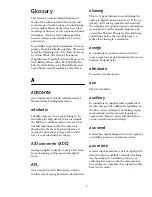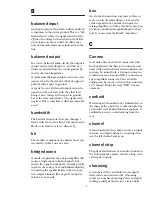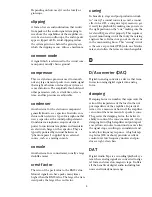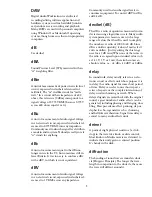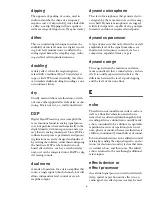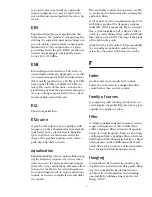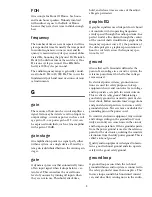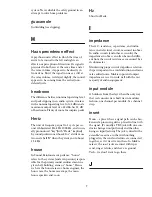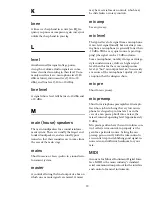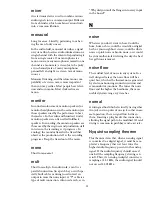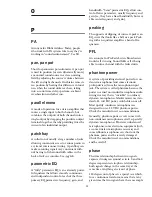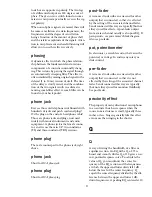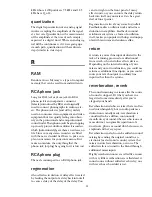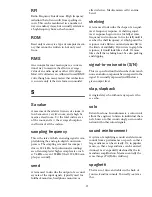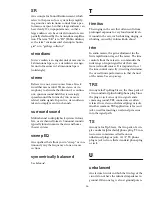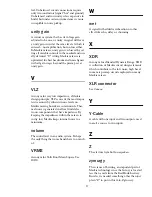
14
kHz whose -3 dB points are 7.5 kHz and 12.5
kHz has a Q of 2.
quantization
The digital representation of an analog signal
involves sampling the amplitude of the signal
at a fast rate. Quantization is the measurement
of the amplitude at the time of each sample,
expressed is a digital word. Where an analog sig-
nal will be continuous as if it were going up a
smooth path, quantization will have discrete
steps (similar to stair steps).
R
RAM
Random Access Memory is a type of computer
memory that can be read from and written to.
RCA phono jack
Long for
RCA jack
or
phono jack
. An RCA
phono jack is an inexpensive connector
(female) introduced by RCA and originally
used to connect phonographs to radio receiv-
ers. The phono jack was (and still is) widely
used on consumer stereo equipment and video
equipment but was quietly fading into obscu-
rity in the professional and semi-professional
sound world. Then phono jacks began cropping
up in early project-studio multitrack recorders,
which (unfortunately) gave them a new lease on
life. Since so many stereo recorders are fitted
with them, we decided we’d have to put a cou-
ple on our mixers for your convenience. But
make no mistake: the only thing that the
phono jack (or plug) has going for it is low cost.
RCA phono plug
The male counterpart to an RCA phono jack.
regeneration
Also called recirculation. A delay effect created
by feeding the output of a delay back into itself
to cause a delay of the delay of the delay. You
can do it right on the front panel of many
effects units, or you can route the delay return
back into itself on your mixer. Can be a great
deal of fun at parties.
Regeneration is also a fancy name for
feedback
.
Feedback makes oscillators work and reduces
distortion in amplifiers. Feedback in sound
reinforcement systems, a form of oscillation
itself, makes you popular with dogs and unpop-
ular with musicians and audience alike.
return
A return is a mixer line input dedicated to the
task of returning processed or added sound
from reverb, echo and other effects devices.
Depending on the internal routing of your
mixer and your own inclination, you could use
returns as additional line inputs, or you could
route your reverb outputs to ordinary line
inputs rather than the returns.
reverberation, reverb
The sound remaining in a room after the source
of sound is stopped. It’s what you hear in a
large tiled room immediately after you’ve
clapped your hands.
Reverberation and echo are terms that are often
used interchangeably, but in audio parlance a
distinction is usually made: reverberation is
considered to be a diffuse, continuously
smooth decay of sound, whereas echo is one or
more distinct, recognizable repetitions of a
word, note, phrase or sound which decreases in
amplitude with every repeat.
Reverberation and echo can be added in sound
mixing by sending the original sound to an
electronic (or electronic/acoustic) system that
mimics natural reverberation, or worse. The
added reverb is returned to the blend through
additional mixer inputs.
Highly reverberant rooms are called live; rooms
with very little reverberation are called dead. A
sound source without added reverb is dry; one
with reverb or echo added is wet.


